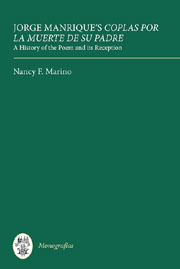Book contents
- Frontmatter
- Contents
- Dedication
- Acknowledgements
- Preface
- Chapter 1 The Author and His work
- Chapter 2 The Renaissance and Baroque Eras
- Chapter 3 Reception in the Eighteenth to Twenty-First Centuries
- Chapter 4 Shifting Literary Perspectives
- Afterword
- Appendix A Five Centuries at a Glance: A Selection of Comments about the Coplas
- Appendix B Additional Literary Responses since 1800
- Bibliography
- Index
Chapter 2 - The Renaissance and Baroque Eras
Published online by Cambridge University Press: 05 February 2013
- Frontmatter
- Contents
- Dedication
- Acknowledgements
- Preface
- Chapter 1 The Author and His work
- Chapter 2 The Renaissance and Baroque Eras
- Chapter 3 Reception in the Eighteenth to Twenty-First Centuries
- Chapter 4 Shifting Literary Perspectives
- Afterword
- Appendix A Five Centuries at a Glance: A Selection of Comments about the Coplas
- Appendix B Additional Literary Responses since 1800
- Bibliography
- Index
Summary
Glosses
Glossing popular cancionero poems was in fashion in the second half of the fifteenth century, and most glosses were composed on short, amorous works such as canciones, or after motes. Jorge Manrique wrote glosses, the most famous of which has the memorable verse “Sin Dios, sin vos, y mí”; he also glossed a couple of motes, including his own motto “Ni miento ni m'arrepiento.” One of the most famous songs in the sixteenth century was composed for his poem “Justa fue mi perdición,” which also inspired thirteen glosses. But the length and more serious themes of the Coplas did not lend themselves to the typical courtly gloss, and in no cancionero can we find such a reworking of the poem. But its moral nature and universal message begged for expansion in verse or commentary in prose, a challenge that was taken up twelve times in the sixteenth century. Although the first work of this kind appears at the opening of the century, the mid-1500s would see a flurry of different glosses of the Coplas, clearly indicating that this was a period of great popularity for the poem.
Perhaps the best summary of the reasons for the fame and popularity of the Coplas in the 1500s can be found in the prologue to the second of its glosses to be printed, Rodrigo de Valdepeñas's text. These introductory remarks were not written by El Cartujo himself, who had been unaware of the publication of his work (as we shall see further on), but by one Alonso de Callejas, whose identity is unknown.
- Type
- Chapter
- Information
- Jorge Manrique's 'Coplas por la muerte de su padre'A History of the Poem and its Reception, pp. 34 - 94Publisher: Boydell & BrewerPrint publication year: 2011



